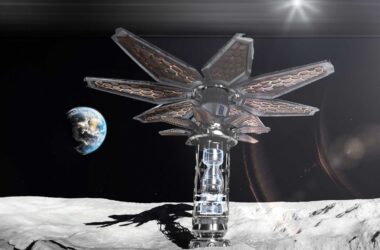Space has always captivated humanity. As we dream of exploring distant planets and galaxies, one company is making strides to turn these dreams into reality. Enter nuclear fusion propulsion, a groundbreaking technology with the potential to revolutionise space travel.
Imagine halving the time to reach Mars or journeying to Saturn’s moons in just two years. This isn’t a sci-fi novel; it’s the future Pulsar Fusion is building.
Pulsar Fusion: At the Forefront of Nuclear Propulsion
Pulsar Fusion, a UK-based company, is actively developing and implementing fusion propulsion technology.

Recognising the limitations of traditional propulsion methods, especially for extended space missions, the company has initiated the construction of a fusion rocket engine in Bletchley. This project aims to harness the power of nuclear reactions, similar to those observed in the Sun, for propulsion purposes.
The concept of nuclear fusion propulsion has been explored for some time, but Pulsar Fusion’s approach is grounded in practical application and research. The company focuses on creating a fusion chamber to achieve the specific conditions required for stable nuclear fusion reactions. The potential benefits of this technology include increased travel speeds and reduced fuel requirements, making long-duration space missions more feasible.
The development of fusion propulsion presents technical challenges, primarily related to achieving and maintaining the conditions necessary for fusion. Pulsar Fusion’s team, comprising scientists and engineers, addresses these challenges through rigorous research and testing. Collaborative efforts and the company’s investment in advanced facilities and equipment underscore its commitment to advancing this technology.
The Engineering Behind Fusion Propulsion
Nuclear fusion propulsion operates on a principle that has long fascinated scientists: harnessing the reactions that power our Sun for propulsion. At its core, this technology seeks to replicate these reactions in a controlled environment, specifically within a rocket engine, to generate thrust.
The process involves confining ultra-hot plasma within an electromagnetic field. When heated to extreme temperatures, this plasma undergoes nuclear fusion reactions, releasing a tremendous amount of energy. This energy, in turn, can propel a spacecraft at speeds significantly higher than those achievable with conventional propulsion methods.
The practical application of fusion propulsion has its challenges. One of the primary hurdles is achieving the ultra-high temperatures and pressures required for fusion. Additionally, the confinement of the plasma, ensuring its stability over extended periods, presents technical difficulties.
These challenges have been the focus of extensive research and development efforts by Pulsar Fusion and other entities in the field.
The potential advantages of fusion propulsion are significant. Firstly, it promises much faster travel times. For instance, missions to Mars could be completed in half the time compared to current propulsion methods. Additionally, fusion propulsion is more fuel-efficient, reducing the fuel a spacecraft must carry for long-duration missions.
Furthermore, the type of engine developed by Pulsar Fusion, known as a Direct Fusion Drive (DFD), offers additional benefits. In a DFD, charged particles create thrust directly without converting it into electricity. This direct approach is more efficient than alternative methods and requires a smaller fuel payload.
In a broader context, successfully developing and implementing fusion propulsion could redefine space exploration, making distant planets and even interstellar travel more accessible.
The Team and Collaboration
A robust team of professionals and strategic collaborations underpins Pulsar Fusion’s endeavours in fusion propulsion. The company’s team is a diverse blend of rocket engineers, scientists, and experts, each bringing a wealth of knowledge and experience. Their combined expertise is crucial in navigating the complexities of nuclear fusion and its application in propulsion.
One of the companies’ collaborations is with Princeton Satellite Systems, based in the U.S. This partnership aims to leverage advanced supercomputer simulations to better understand plasma behaviour, especially under electromagnetic confinement. Such simulations are invaluable in predicting how plasma will react in real-world scenarios, informing the design and operation of the fusion rocket engine.
Beyond simulations, the collaboration also focuses on modelling how plasma would behave when exiting a rocket engine. This data is pivotal in refining Pulsar Fusion’s rocket engine design to ensure optimal performance and safety.
The company’s commitment to research and development is further evidenced by its association with renowned institutions. In 2022, Pulsar Fusion received funding from the U.K. Space Agency to develop a nuclear-fission-based propulsion system. This project, undertaken in collaboration with the Nuclear Advanced Manufacturing Research Centre and Cambridge University, showcases the company’s multifaceted approach to propulsion technology.
The Future of Interstellar Travel
The realm of space exploration is on the cusp of a transformative shift, with fusion propulsion poised to play a central role. The technology’s inherent advantages position it as a leading candidate for deep space missions, offering solutions to challenges that have long constrained our reach into the cosmos.
One of the most compelling benefits of fusion propulsion is its energy efficiency. The reactions involved in fusion release vast amounts of energy from a relatively small amount of fuel. This energy density translates to faster travel speeds, potentially reducing the duration of missions to distant celestial bodies. For instance, a trip to Titan, Saturn’s moon, could be shortened from 10 years to just two with fusion propulsion.
The Direct Fusion Drive (DFD) engine, which Pulsar Fusion is developing, offers a more direct and efficient method of generating thrust. By harnessing the charged particles from fusion reactions, the DFD creates thrust without the intermediate step of converting energy into electricity. This streamlined process further enhances the engine’s efficiency and reduces the need for large fuel payloads.
Beyond the technical advantages, fusion propulsion also presents broader implications for space exploration. Faster and more efficient travel could facilitate more frequent and diverse missions, expanding our understanding of the universe. It could also pave the way for human-crewed missions to distant planets, bringing the dream of interstellar travel closer to reality.
Pulsar Fusion’s CEO Richard Dinan encapsulates the sentiment aptly: “If we’re going to leave our solar system within a human lifetime, fusion propulsion is the technology to make it happen.”
While challenges remain in perfecting fusion propulsion, its potential is undeniable. As research progresses and technology matures, fusion propulsion may become the cornerstone of future space exploration endeavours.
As the space industry evolves, the quest for efficient and sustainable propulsion methods remains paramount. Pulsar Fusion’s dedication to advancing fusion propulsion technology is pivotal in this journey. The company aims to redefine the boundaries of space exploration by harnessing the immense power of nuclear fusion.
The challenges associated with fusion propulsion are substantial, from achieving the conditions for stable fusion reactions to ensuring plasma’s safe and effective confinement. However, with the combined expertise of its team and strategic collaborations, Pulsar Fusion is well-equipped to navigate these complexities.
The company’s vision extends beyond mere technological advancement. It encompasses a broader aspiration to expand humanity’s reach into the cosmos, making distant planets and galaxies more accessible. The potential benefits of this technology, from reduced travel times to increased fuel efficiency, could revolutionize both human-crewed and uncrewed space missions.
In the story of space exploration, fusion propulsion represents a promising new chapter, combining science, innovation, and ambition.
TL:DR
- Pulsar Fusion is pioneering the development of nuclear fusion propulsion for space travel.
- Fusion propulsion can halve travel times to celestial bodies like Mars.
- The company is constructing Bletchley, U.K.’s largest fusion rocket engine.
- The technology involves harnessing reactions similar to those that power the Sun.
- Challenges include achieving ultra-high temperatures and confining plasma within an electromagnetic field.
- Collaborations like Princeton Satellite Systems are crucial for advancing technology.
- The potential speeds achievable with fusion propulsion can reach up to 500,000 miles per hour.
- Fusion propulsion is seen as the future of interstellar travel, making distant planets and galaxies more accessible.








